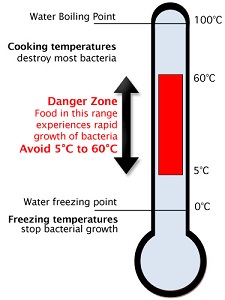Food Poisoning
Food-borne pathogens can occur if food is contaminated. This can occur anywhere from the harvesting process to when your meal is being prepared. Most commonly, the food-borne pathogen is transferred by cross-contamination. This is the process where harmful organisms are transferred from one surface to another.
Normally, there are many other side effects than stomach pains. If you have food poisoning, you might also have some of the following symptoms:
- Diarrhoea
- Vomiting
- Mild Fever
- Weakness
- Nausea
- Headaches
Specific Food Pathogens
The following seven pathogens listed are the most popularly contracted food-borne pathogens that affect consumers.Salmonella
One of the most common types of food-borne pathogen that people fall for! After 1 – 3 days, this bacteria can cause pain for up to 4 – 7 days. It’s caused by raw or contaminated meat, poultry, milk or egg yolks and can be easily cross-contaminated.Norovirus
Norovirus occurs in the host’s body as a virus. It is caused by unsanitary food preparation – simple things like not washing your hands can cause norovirus.Campylobacter
This is bacteria that is a common cause of gastroenteritis (also known as ‘gastro’). It takes 2 -5 days before it affects the host and it is normally caused by animal faeces being in contact with meat surface. It can also be caused by unpasteurised milk and contaminated water.Clostridium Botulinum
If you keep your food in a warm environment for too long, it can cause bacteria to grow in your food. It takes about 12 – 72 hours for the bacteria to take full effect on the host.Escherichia Coli (E. coli)
This bacterium is normally found in the intestines of all humans and animals. When it is found on food, it has dire effects. Generally, it takes anywhere from 1 – 8 days before symptoms arise in the victim. E. coli can be found in beef contaminated with faeces during slaughter or during the production process. It survives the production stage mainly through under cooked ground beef. Other sources include unpasteurised milk and apple cider, alfalfa sprouts, and contaminated water.Hepatitis A
This is a virus that can be contracted through an infected food handler. It can take up to 28 days before symptoms take effect and can be found in raw, ready-to-eat produce and shellfish from contaminated water.Listeria
This is one fast acting pathogen. Within 9 – 48 hours of consumption, the victim can start feeling the effects. Caused by contaminated soil and water in the harvesting process, it can be found in luncheon meats, unpasteurised milk and cheeses, and unwashed raw produce.Food Temperature
How to avoid food poisoning
Avoid cross contamination
Avoid the chances of germs transferring from an unclean source to food. Methods include:- washing hands when entering the kitchen
- washing hands between processes
- dedicated chopping boards for meat and vegetables
- washing worktops
- keeping raw meat away from ready-to-eat foods
Avoid the danger zone
5°C to 60°C is the danger zone. It is critical to store and transport potentially hazardous foods below 5°. When cooking and heating food it needs to be heated above 60°. When cooling food it is vital to cool ALL of the food to below 5° within a couple of hours. Potentially hazardous foods that are left in the danger zone for an extended period need to be disposed of.Avoid high risk foods
Raw egg dishes are high risk. Undercooked meat is higher risk. And if you do insist on higher risk food, make sure that you avoid the danger zone, and dispose of excess rather than storing it for extended periods.Avoid undercooked
Some meats such as chicken and pork are higher risk than others. Also mince is much higher risk than a whole piece of meat. Higher risk meat needs to be cooked properly (heated to above 70°C) to ensure bacteria is killed. NOTE: Cooking will not kill bacteria in seafood. If in doubt, toss!The Food Safety Check List
Food handling
- Food protected from the possibility of contamination
- Meat stored below other items in fridge
- Potentially hazardous foods stored below 5°C
- Food cooled within the 2/4 hours from 60°C to 5°C
- Food heated quickly fro
- HACCP compliant thermometer used
- BONUS for temperature loggers used in fridges and freezers
- Items thawed correctly
- Items processed quickly if at room temperature
- Surfaces cleaned
Health and hygiene
- Food handlers wash and dry hands
- Before commencing/recommencing work
- After using the toilet, sneezing, smoking or handling raw meat
- After cleaning
- All staff are trained in how to wash their hands (using Glitterbug)
- Staff wash their hands for 20 seconds minimum
- Dedicated hand wash facility available with warm water, soap, brush and single use towels
- No spitting or smoking in food handling areas
- No eating over exposed food or food contact surfaces
Animals and pests
- Animals not permitted in food handling areas
- Practical pest exclusion measures
Food
- Food and packaging undamaged
- No food used or sold beyond its use by date
- No cracked or dirty eggs
- Unused potentially hazardous food in danger zone disposed of
Environment
- Ceiling, walls and floors free from cracks and damage
- Food processing benches free from cracks and damage
- All equipment free from rust, damage and deterioration
- Staff amenities clean and tidy
- Rubbish only in rubbish bins
- Cleaning chemicals and other poisons stored separately and clearly labelled
Staff
- At least one (why not all?) person on duty has been trained in Food Safety
- Staff are healthy and do not have the flu, vomiting or diarrhoea.
- Staff are happy. You are happy

Want to know what a restaurant’s attention to food safety is without entering the kitchen?
Look at the toilets and rubbish bins.
If staff take the time to keep them neat and clean then they will probably be looking after everything with the same care. If they are a disgusting mess, then consider eating elsewhere.

